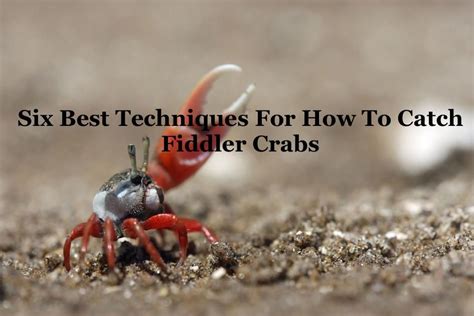Guaranteed Fiddler Crab Catching Techniques: A Comprehensive Guide
Fiddler crabs, with their distinctive oversized claws and charming antics, are a favorite among beachcombers and nature enthusiasts. Catching these tiny crustaceans can be a fun and rewarding experience, but success hinges on understanding their behavior and employing the right techniques. While no method guarantees a catch every time (nature is unpredictable!), this guide outlines proven strategies to significantly increase your chances of a successful fiddler crab hunt.
What Time of Day is Best for Catching Fiddler Crabs?
Timing is crucial. Fiddler crabs are most active during low tide, when their burrows are exposed and they venture out to feed and interact. The best time to catch them is typically during the hour or two before and after low tide. Avoid the midday sun, as the crabs tend to retreat into their burrows during the hottest part of the day. Early mornings and late evenings are also favorable times, offering cooler temperatures and less direct sunlight.
What is the Best Bait to Use for Fiddler Crabs?
Bait selection matters. While some people have success with store-bought crab bait, fiddler crabs are surprisingly opportunistic feeders. Small pieces of raw meat (like chicken or fish), bread crumbs, or even bits of seaweed can work well. Experiment to see what works best in your specific location. The key is to offer small, easily manageable portions.
What Kind of Traps Can I Use to Catch Fiddler Crabs?
Traps can boost your success, but they are often unnecessary. A simple, shallow container (like a small bucket or bowl) placed near the burrow entrance, baited with a small piece of food, can lure crabs inside. Alternatively, some enthusiasts use small, homemade traps constructed from mesh or wire. Remember always to handle crabs gently and return them unharmed to their habitat after observation.
Where is the Best Place to Look for Fiddler Crabs?
Knowing where to look is half the battle. Fiddler crabs thrive in intertidal zones, the areas between high and low tide. Look for muddy or sandy areas with numerous small holes, which indicate the presence of burrows. Areas with vegetation or debris often provide shelter and attract a greater concentration of crabs. Pay close attention to areas with less human disturbance.
How Do I Catch Fiddler Crabs Without a Trap?
Hand-catching is a popular and effective technique. Approach slowly and quietly to avoid startling the crabs. Once you spot a crab, gently scoop it up with a small container or your hands (using caution as they may pinch). Remember to always be gentle and handle the crab with respect.
How Can I Attract Fiddler Crabs to a Specific Location?
Creating an attractive environment can draw crabs to a specific area. Adding small amounts of organic matter (like seaweed or decaying plant material) can enrich the soil and make it more appealing. Remember that maintaining a clean and natural habitat is paramount for their survival.
Are There Any Specific Tips or Tricks for Catching Fiddler Crabs?
Patience and observation are key. Spend some time watching the crabs before attempting to catch them. Learn their patterns and movements to increase your chances of success. A calm and patient approach will yield better results than a frantic chase. Remember to check local regulations and obtain necessary permits before collecting crabs.
Conclusion: Responsible Fiddler Crab Catching
While these techniques significantly improve your odds of catching fiddler crabs, it’s crucial to remember responsible practices. Always handle crabs gently, avoid disturbing their burrows unnecessarily, and promptly return them to their habitat after observation. Respecting their environment ensures a continued enjoyment of these fascinating creatures for years to come. Remember to always check local regulations and obtain any necessary permits before collecting fiddler crabs. Happy hunting!

